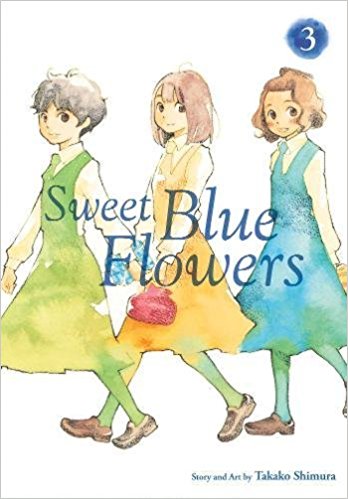By Takako Shimura. Released in Japan as “Aoi Hana” by Ohta Shuppan, serialized in the magazine Manga Erotics F. Released in North America by Viz. Translated by John Werry.
Everyone wants to read about the awkward pangs of unrequited love. Will they feel the same way? Will they hate me? Will this destroy our friendship? But it has to be said, and Sweet Blue Flowers does a very good job at conveying this, the issues don’t magically go away after you’ve started dating. Admittedly Akira’s acquiescence is somewhat lukewarm, which is no doubt why Fumi is feeling this way. But let’s face it, Fumi is the sort of person to overthink things anyway, and these sorts of worries DO stick around. Communication does not necessarily become easier when you’ve confessed. In many ways it’s harder. And of course if you want to keep dating, you have to keep yourself interesting and fun, because what if your partner gets bored with the real you? Sweet Blue Flowers may not be getting any closer to resolution of its main romance, but it certainly knows how to convey its painful emotions.
Sweet Blue Flowers does feature an awful lot of relationships between girls, but unlike some other series of this ilk, they aren’t every single relationship. There are men in this world. Indeed, sometimes the reader thinks that the man is the better choice – Ko breaks up with Kyoko here, and you can’t blame him, but I honestly do hope that she gets it together and gets back together with him, as he’s a good guy, and her pining away is not getting her anywhere. It’s weird to feel this way in a yuri manga, where the nature of fandom tends to regard any man who might get in the way of a relationship between two women as evil. We also have different types of relationships here – Akira and Fumi start to date, but it’s very vague, and you get the sense they’re doing it so that Akira can figure things out more than anything else. Some of the girls in the school are clearly in an “akogare” situation that they’re going to grow out of, but some are not – one of the minor characters outright says she’s a lesbian, and Akira’s teacher is in a happy relationship with another woman. This isn’t just yuri’s classic “Story A“. (Well, OK, sometimes it is.)
Sweet Blue Flowers, of course, also has the same issues that it’s had before. Shimura’s character designs are too damn similar, and I find myself struggling to tell some of the girls apart, which makes it harder for me to remember the plotlines. Akira and Fumi’s teenage passion and fears are endearing but also exhausting, especially given this is an omnibus of two separate volumes. And I have to confess, I don’t like Yasuko all that much, and was irritated when she showed up again. Her going to England really helped this series find its feet. That said, this is still a very good volume, and since I believe it ends with the fourth book, there’s no reason for you not to get it so that you can wallow in panga of young love once more.

